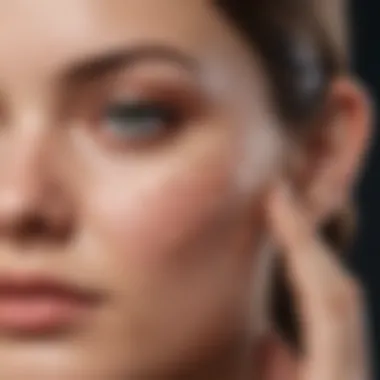Effective Strategies for Pimple Management and Clear Skin


Intro
Pimple management is a common concern. It affects people of all ages. Understanding effective strategies can lead to clearer skin. The truth is many do not realize solid routines and lifestyle choices can help.
This article discusses the wniping causes of pimples, attainable daily regimens, and misconceptions. It offers a balance of knowledge and practical tips. To manage and diminish pimples, it’s essential to adapt informed practices accordingly.
Causes of Pimples
Pimples arise from various factors:
- Hormonal changes: Common in teenagers and women during menstruation.
- Diet: Consumption of dairy products and high glycemic index foods can trigger breakouts.
- Stress: It affects overall health and can lead to skin flare-ups.
- Skincare products: Greasy or heavy products can block pores.
Understanding these causes sets a foundation for improvement. Adjustments to lifestyle habits help address underlying issues effectively.
Skincare Routine Tips
Implementing an appropriate skincare routine is crucial. Start with these aspects:
- Cleansing: Use a gentle cleanser twice daily.
- Exfoliating: Light exfoliation once or twice a week can help remove dead skin cells.
- Moisturizing: Use oil-free moisturizers suitable for your skin type.
Applying effective products routinely cultivates healthy skin.
Lifestyle Choices
The lifestyle choices one makes can greatly impact skin condition.
- Hydration: Drinking adequate amounts of water remains essential. It helps maintain moisture.
- Nutrition: Consuming plenty of fruits and vegetables nurtures skin health.
- Sleep: Plenty of quality rest aids skin regeneration.
Little choices can result in significant change.
Common Misconceptions
Some misconceptions exist regarding pimple management:
- **
Understanding Pimples
Understanding the dynamics of pimples is crucial for those seeking effective management of their skin issues. Pimples are not merely superficial blemishes; they signify underlying factors that can affect overall skin health. Identifying the definition, causes, and types of pimples provides insight, enabling individuals to make informed decisions about their care. This section serves as the foundation for further discussions on management strategies, underscoring the importance of a structured approach in addressing pimple issues.
Definition and Causes of Pimples
Pimples are localized inflammations typically caused by clogged hair follicles. Each follicle may hold sebum, bacteria, and dead skin cells, an environment conducive to pimples. Hormonal shifts, particularly during puberty or menstruation, exacerbate sebum production, leading to overactive oil glands. Introduced from external irritants, pimples can develop due to poor skincare techniques, unsuitable products, or stress.
Common Misconceptions
There are various common misconceptions regarding acne. Many believe that resting a facial oil or product on the skin results in quick relief. Others presume that excessive scrubbing eliminates oil and dirt. However, such practices often produce counterproductive effects. Additionally, some consider that diets rich in chocolate worsen acne; scientific evidence here remains inconclusive. Clearing up these misunderstandings may lead to more effective management techniques.
Types of Pimples
Pimples manifest in different forms, each possessing unique characteristics and implications for management strategies. Different variations include the following:
Whiteheads
Whiteheads appear as small, flesh-colored or white bumps on the skin. They are formed when hair follicles remain closed due to excess oil and keratin. The specific aspect of whiteheads lies in their relatively closed nature; this preventive feature aids in protecting acids or bacteria from external exposure. While easier to conceal, they may persist for longer if not managed properly. Therefore, understanding how to treat them effectively can contribute significantly to clear skin.
Blackheads
Unlike whiteheads, blackheads have an open surface, giving them a dark or black appearance. This is caused by oxidation of the trapped sebum when known to air. Their unique feature is their non-inflamed state; blackheads are often treated without intensive intervention or rare complications. Considering their generally straightforward management, addressing them properly can assist in maintaining skin health.
Cystic Pimples
Cystic pimples are characterized by large, swollen lumps beneath the skin’s surface and accompanied by intense pain and redness. They develop from blocked follicles suffering from deeper issues. Understanding cystic pimples is key, given their tendency for scarring, which requires more specialized approaches. The treatment of cystic acne is often more challenging than blackheads or whiteheads, thus warranting appropriate intervention early on.
Understanding the classification of pimples helps individuals create tailored routines for effective management and treatment.
Daily Skincare Practice


Daily skincare practice is a vital element in effective pimple management. It serves not only to maintain a clean complexion but also to prevent future breakouts. Pimple issues largely stem from excess oil, dirt, and bacteria. Thus, creating a daily regimen tailored to your skin’s needs can curtail these factors.
Cleansing Your Skin
Maintaining clean skin is the foundation of any skincare routine. This involves correctly choosing and applying the right products for optimal results.
Choosing the right cleanser
Selecting the appropriate cleanser is fundamental. A good cleanser acts to remove impurities without stripping the skin's necessary oils. Ideally, a cleanser should be gentle and suited for one’s skin type. For example, gel-based cleansers benefit oily skin, while cream-based options iidealfor dry skin. Properly chosen products can help reduce breakouts by ensuring that pores stay unclogged.
The unique feature of the right cleanser is its formulation. Many are made with pimple-fighting ingredients, such as salicylic acid. These beneficial components help to keep skin clear of bacteria and prevent inflammation. However, not all cleansers are the same. Some highly fragrant products can trigger irritation rather than soothe.
Proper cleansing techniques
Effective cleansing also relies on technique. For optimal cleansing, start by wetting the face with lukewarm water. Apply a small amount of cleanser and gently massage it into the skin using circular motions for about 30 seconds. Rinse thoroughly to remove all traces of product. It is advisable to cleanse twice per day—once in the morning and once before bed.
Proper technique ensures maximum cleaning, enabling products to penetrate skin better. Using harsh scrubbing motions can lead to breakouts due to irritation, so gentleness is essential. Another downside of poor technique is the likelihood of missing areas of your face, allowing dirt and oil to build up, ultimately worsening pimple problems.
Moisturizing Effectively
Many people believe moisturizer might worsen oily skin. However, hydration is crucial for maintaining a clear complexion. It plays a significant role in skin health and pimple prevention.
Importance of hydration
Hydrating the skin assists in rebuilding its natural barrier while preventing excessive oil production, a significant factor in breakouts. Well-hydrated skin prompts a more balanced production of sebum. This naturally limits pore clogging which leads to acne.
Furthermore, keeping skin well-hydrated improves its overall texture and appearance. When the skin loses moisture, it can lead to complications such as increased irritation and sensitivity. Options like lightweight gels or lotions with a water base provide excellent hydration without adding heaviness.
Selecting non-comedogenic products
When moisturizing, picking non-comedogenic options is vital. These products are formulated so that they do not clog pores, significantly reducing the likelihood of breakouts. Many brands classify their products this way. It's key to read labels.
This is particularly crucial for those with oily skin types. Non-comedogenic products often contain beneficial ingredients like hyaluronic acid, which draws moisture without adding oil. If one mistakenly uses comedogenic products, it can negate cleansing efforts resulting in the frustration of persistent pimples.
Sun Protection
Sun exposure can worsen existing pimples and lead to further skin complications. Daily sun protection is non-negotiable for maintaining skin health.
Using broad-spectrum sunscreen not only protects against harmful UV rays but also helps avoid pigmentation and early aging of the skin. Sunscreen should be a daily inclusion, even on cloudy days. Looking for oils and creams containing SPF can simplify one step in the skincare routine. Ignoring sun care can lead to a range of issues, including sunburn and heightened inflammation of existing pimples.
In essence, consistent daily skincare dominates overall skin health and is crucial for pimple management. Use it as a foundational approach alongside prescribed treatments, both over-the-counter and professional, to realize best results.
In summary, daily skincare practice is vital in controlling and preventing breakouts through consistent cleansing, each with appropriate techniques and products tailored to skin type.
Treatment Options
Treatment options are crucial in the journey to manage and prevent pimples effectively. Various methods exist, allowing individuals to select according to their skin conditions and preferences. Knowing the right approach can empower people to better coordinate their skincare efforts and minimize breakouts, helping them achieve clearer skin more efficiently.
Over-the-Counter Solutions
Benzoyl peroxide
Benzoyl peroxide is a widely recognized treatment for acne due to its ability to kill bacteria that cause inflammation. This compound features particular traits that make it desirable in pimple management. It can unclog pores and prevent future breakouts by reducing excess oil.
One distinctive quality is its availability; it can be found in varying concentrations from many skin products available at local shops. Users may experience some dryness or irritation at first, necessitating careful monitoring. While effective overall, use it judiciously to avoid over-drying your skin.
Salicylic acid
Salicylic acid is another popular choice among over-the-counter products. It works primarily by penetrating deep into the pores, dissipating dead skin and minimizing clogging. Note how it can help exfoliate your skin, keeping it fresh and clear.
Notably, salicylic acid has a property that makes it beneficial for all types of pimples, especially those that are in the early stages of forming. Some people might notice a mild tingling sensation, indicating its action. It's essential to apply sunscreen when using salicylic acid, as it can increase sun sensitivity.
Retinoids
Retinoids are a category of substances containing vitamin A derivatives that play a crucial role in skin cell production. They contribute to reducing acne by promoting faster skin turnover. With their capacity to minimize fine lines, sunscreens and moisturizers should complement their use effectively.
One unique feature of retinoids is their long-term payoff. Although improvements often take weeks, consistent application typically leads to fewer breakouts and improved skin texture. However, some initial irritation is common. Starting slow and gradually increasing dosing can help mitigate adversity.


Prescription Treatments
Topical antibiotics
Topical antibiotics provide a direct solution for targeted infections. They work to decrease the number of bacteria on the skin's surface. A key attribute of these antibiotics is their effectiveness in spot treatment for stubborn areas that do not improve with over-the-counter remedies.
Nevertheless, someone should assess their dermatitis before incorporating antibiotics, as many dermatologists recommend them thoughtfully to limit dependency.
Oral medications
Doctors often prescribe oral medications for more persistent or severe forms of acne. Oral treatments can address both hormonal and bacterial contributions to pimple formation. The main advantage of these prescriptions is their ability to act from within the body, simplifying application.
However, possible side effects should be noted,such as dryness, and they require consistent follow-up appointments to monitor progress and reactions.
Hormonal treatment options
Hormonal treatment options are significant for women dealing with acne linked to hormonal fluctuations. Treatments like birth control pills can improve skin appearances by regulating hormones and consequently, acne.
These treatments have beneficial modifications that assist in the long-term effects over time. However, healthcare consultations remain vital for management precision.
Natural Remedies
Tea tree oil
Tea tree oil stands out due to its natural antibacterial properties. Known for being gentle on the skin, it's an organic alternative. It can be applied with a diluted solution, acting as a soothing corrective. Many enjoy its non-chemical effective means to help reduce inflammation.
However, essential oils require diluted forms to avoid unchecked irritation; someone's skin test before use is advisable.
Aloe vera
Aloe vera presents a remarkable option for its soothing and hydrating characteristics. Beneficial for many acne sufers, it combats redness and inflammation while keeping the skin moisturized.
The gel-like consistency penetrates comfortably and promotes skin renewal. Aloe vera's broad effectiveness makes it an excellent home remedy though sensitivity varies per individual.
Green tea extracts
Finally, green tea extracts provide potent antioxidants that play a part in mitigating acne development. Their primary reputation is for reducing sebum production and skin irritation. Picking products that feature concentrated extracts might yield better results than general washes or creams too.
Boost your usage with consumption; drinking green tea comprising these properties could visualise further advantages.
Using the plethora of options highlighted here provides solutions to suit personal needs in the complex fight against acoustics like Sher music — collaborate, Studien your expectations effectively, finding systems that resonate.
Effective engagement with your skin routine can mean a clear horizon for managing pimples. Make consultation and subsequent assessment part of your ongoing journey!
Lifestyle Factors
The connection between lifestyle factors and skin health is significant. Many do not realize that our daily habits can have a profound impact on the occurrence of pimples. A well-balanced approach combining nutrition, stress management, and adequate sleep can reduce the likelihood of breakouts, leading to clearer skin. Focusing on these elements allows individuals not just to tackle the symptoms of acne but also to address potential underlying causes.
Diet and Nutrition
Foods to incorporate
Incorporating specific foods in the diet can play an important role in managing pimples. Foods rich in antioxidants, such as berries, tomatoes, and nuts, help combat oxidative stress, which can worsen skin issues. These antioxidants contribute to overall skin health by supporting the repair of damaged cells. Additionally, foods high in omega-3 fatty acids, like fish and flaxseeds, possess anti-inflammatory properties that can minimize redness and swelling associated with pimples. Ensuring a good intake of fruits and vegetables can boost skin health significantly.
Foods to avoid
On the other hand, certain foods can promote skin problems. Refined sugars, found in many processed snacks and drinks, can trigger an inflammatory response and increase oil production in the skin, leading to further breakouts. Dairy products are also a concern; some studies suggest a connection between dairy and acne, likely due to hormones present in milk. Avoiding these foods can aid in keeping skin clearer. It's essential to be mindful of dietary choices, as they can significantly affect skin condition.
Stress Management
Benefits of mindfulness
Mindfulness is a key aspect in managing stress levels, which directly influence skin health. Practicing mindfulness allows individuals to remain present and engaged with their thoughts, reducing anxiety. Decreased stress can lead to lower cortisol levels, a hormone often associated with increased oil secretion in skin glands. Overall, mindfulness promotes a more positive mindset, which can impact one’s skin condition positively.
Exercise and its impact
Exercise serves as a direct tool in reducing stress and improving overall skin clarity. Physical activity increases blood flow, delivering more oxygen and nutrients to skin cells. Moreover, regular exercise helps balance hormones and pulls toxins from the body through perspiration. It’s also a natural way to uplift one’s mood; endorphins released during exercise act as body’s natural pain relievers and mood lifters. Consequently, incorporating routine exercise can lead to twofold benefits: managing stress and enhancing skin health.


Sleep and Skin Health
Sleep plays a critical role in pimple management. When the body undergoes sleep, it engages in repair and regeneration processes, which are essential for skin. Lack of sleep can elevate stress levels and increases the prevalence of skin irritation due to not allowing the body adequate time to heal. The skin’s barrier function is also optimized during sleep, contributes to a clear complexion. Proper sleep hygiene is paramount in achieving overall skin well-being, supporting the argument that good lifestyle choices profoundly affect skin clarity.
Seeking Professional Help
The need for professional help in managing pimples cannot be overstated. Even with a solid understanding of skin care practices and lifestyle adjustments, some cases require advanced intervention. Consulting a dermatologist can be crucial for personalized care, especially for persistent or severe acne. This section explains when to seek help and what types of tailored treatments medical professionals can offer.
When to Consult a Dermatologist
Recognizing when to consult a dermatologist is vital for effective pimple management. Consider visiting a specialist if:
- Over-the-counter remedies have failed to show effective results after a few weeks.
- Pimples are severe, painful, or accompanied by cysts and deep nodules.
- Acne is affecting one's self-esteem or leading to emotional distress.
- Acne seems to worsen or change in nature frequently without clear cause.
- There’s concern about potential scarring from existing pimples.
A dermatologist offers expertise that basic advice or over-the-counter products cannot. Early professional consultation can lead to a better path for treatment and healing.
Types of Dermatological Treatments
There are various types of treatments a dermatologist might recommend. Each offers different benefits that can handle difficult skin conditions effectively. Below are some common treatments:
Chemical Peels
Chemical peels involve applying a solution to the skin that results in a controlled exfoliation. This treatment can clear dead skin cells, helping to reduce the buildup of oil and bacteria. They are popular due to their ability to provide visible improvement with minimal downtime. Their key characteristic is the use of acid solutions, tailored by professionals according to skin type and severity of the condition.
Compared to at-home treatments, chemical peels offer a much stronger and more effective option for managing acne.
However, they may come with some risks, such as heightened sensitivity or irritation immediately following the treatment. It is important to follow professional advice closely for healing and care post-peel.
Laser Therapy
Laser therapy utilizes focused light to target problems beneath the skin surface, such as bacteria disrupting the skin and excess oil production. It is particularly well-known for its quick results and relatively low pain during the procedure. As a beneficial solution for managing moderate to severe acne, laser therapy rejuvenates the skin's appearance while minimizing ongoing outbreaks.
There are potential downsides, primarily cost, since treatments can be more expensive than other methods. Also, some individuals might experience temporary redness post-treatment. Choosing a certified professional is critical for a promising outcome and safety of the procedure.
Photodynamic Therapy
Photodynamic therapy harnesses the power of light to treat acne. It involves applying a special photosensitizing solution to the skin and then exposing it to light, which activates the solution, leading to destruction of acne-causing bacteria. This treatment can safely treat active acne while addressing potential scarring simultaneously.
A significant benefit of photodynamic therapy is its effectiveness for recalcitrant acne cases that do not respond to traditional interventions. However, this therapy typically requires multiple sessions for optimal result and can be an initially uncomfortable experience as well.
In summary, defining the right moment to seek professional advice about pimple management can greatly influence skin outcomes and emotional well-being. Dermatologists offer a variety of modern treatments practiced with expertise, thus paving the way to clearer skin and renewed confidence.
Maintaining Clear Skin
Maintaining clear skin is crucial for both complexion and overall skin health. A consistent skincare practice can effectively reduce the recurrence of pimples. It not only affects physical appearance but also impacts emotional well-being and self-esteem. Building a regimen ensures that the skin remains hydrated, protected, and free of impurities.
Regular attention to pimple management creates a more resilient barrier against external factors. This not only helps in maintaining clear skin but also minimizes long-term damage. Ongoing skin care routines provide the benefits of a visible glow, smooth texture, and improved overall complexion.
Moreover, being consistent aids in discovering what products work well and which to avoid. It simplifies the daily process while tailoring to specific skin needs.
The foundation of clear skin is a well-structured routine, uniquely individualized to meet one’s dermatological requirements.
Building a Consistent Routine
A consistent skincare routine involves a set sequence of steps performed daily. Following a simplified yet effective routine contributes significantly to maintaining clear skin.
Key components include:
- Cleansing: Removing dirt and excess oils.
- Moisturizing: Keeping skin hydrated, regardless of skin type.
- Sunblock: Protecting against UV rays.
Steps to Follow:
- Determine Your Skin Type: Evaluate if it is oily, dry, combination, or sensitive.
- Select Appropriate Products: Look for non-comedogenic labels, avoiding heavy oils.
- Stick to the Routine: Aim for morning and night rituals.
Moreover, regular skin exfoliation helps remove dead cells. This should be performed gently and no more than twice a week to avoid irritation. It is about creating not too much frequency but rather sustaining beneficial habits.
Monitoring Skin Changes
Being attentive to your skin's behavior over time provides valuable insights. Effective observation aids significantly in maintaining clear skin by facilitating timely interventions. Consistent monitoring allows for the early detection of adverse reactions to products or any changes in skin condition.
Consider these points:
- Document Changes: Keep a journal noting breakouts, sensitivities, or improvements after incorporating new products.
- Note Seasonal Effects: Skin can react differently with changing seasons and temperatures.
- Responding to Symptoms: Adjust your routine according to any enduring oddities like increased oil production or persistent dryness.
Utilizing visible checkpoints helps in shaping and fine-tuning the skincare journey. Within preventing further irritation or worsening of skin issues, such attention can enhance both beauty and comfort. Staying aware of these shifts equips individuals better for an optimal pimple management strategy.







